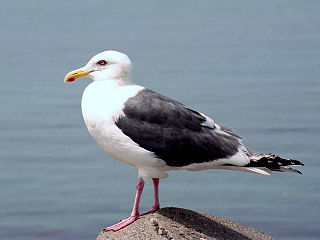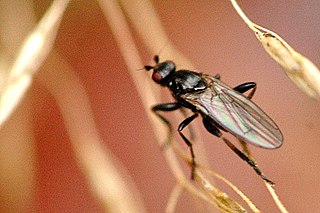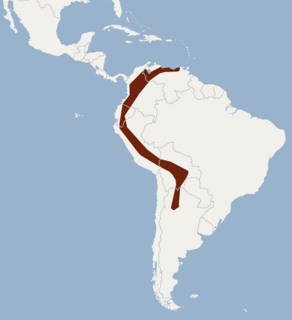
Tiger snakes are a highly venomous snake species found in the southern regions of Australia, including its coastal islands, such as Tasmania. These snakes are often banded like a tiger, and highly variable in their colour and forms in their regional occurrences. All populations are in the genus Notechis, and their diverse characters have been described in further subdivisions of this group; they are sometimes described as distinct species and/or subspecies.

The yellow-footed gull is a large gull, closely related to the western gull and thought to be a subspecies until the 1960s. It is endemic to the Gulf of California.

The slaty-backed gull is a large, white-headed gull that breeds on the north-eastern coast of the Palearctic, but travels widely during nonbreeding seasons. It is similar in appearance to the western gull and the glaucous-winged gull. Another alternate name is Pacific gull, though it also applies to a Southern Hemisphere species, L. pacificus.

Sphaeroceridae are a family of true flies in the order Diptera, often called small dung flies, lesser dung flies or lesser corpse flies due to their saprophagous habits. They belong to the typical fly suborder Brachycera as can be seen by their short antennae, and more precisely they are members of the section Schizophora. There are over 1,300 species and about 125 genera accepted as valid today, but new taxa are still being described.

The Heleomyzidae is a small family of true flies in the insect order Diptera. Over 740 described species of Heleomyzidae occur in about 76 genera distributed throughout the world.

The lesser Asiatic yellow bat is a species of vesper bat. It is found in Bangladesh, India, Indonesia, Malaysia, Pakistan, the Philippines, Sri Lanka, and Taiwan.

The northern yellow bat is a non-migratory bat in the family Vespertilionidae, typically active year-round except during abnormally frigid winter weather, during which they will induce torpor.
The yellow-cheeked chipmunk, also known as the redwood chipmunk, is a species of rodent in the squirrel family, Sciuridae. It is endemic to areas near the coast of northern California in the United States where it inhabits coastal coniferous forest.

The hairy yellow-shouldered bat is a species of bat in the family Phyllostomidae native to South America. There are no recognised subspecies.

The yellow-bellied weasel is a species of weasel that inhabits pine forests in central and eastern Asia.
Poecilosomella is a genus of flies belonging to the family Lesser Dung flies. These small flies, often with attractive patterning on the wings and body, are commonly found in a wide range of habitats throughout the Old World and Australasia.
Poecilosomella brevisecunda is a species of fly belonging to the family Sphaeroceridae. It has only been recorded from Gunung Leuser National Park in northern Sumatra, Indonesia.
Poecilosomella curvipes is a distinctive species of flies belonging to the family Sphaeroceridae. It is only known from Taiwan.

Orectolobus reticulatus, the network wobbegong, is a recently described species of carpet shark found in relatively shallow waters off Kimberley and Darwin in north-western Australia. With a known maximum length of only 52.3 centimetres (20.6 in), it may be the smallest species of wobbegong. Until its description in 2008, it had been confused with the northern wobbegong. The network wobbegong has a short snout, broad head, elongated body, and two dorsal fins, with the first being slightly larger than the second. Its body is grayish brown with darker brown markings and a pale yellow underbelly. The network wobbegong lives in shallow waters along reefy bottoms.
The flagtail swellshark is a little-known species of catshark, belonging to the family Scyliorhinidae, found at a depth of 480–700 m (1,570–2,300 ft) off northeastern Queensland, and possibly also nearby islands. This stout-bodied shark has a short, broad, and flattened head with a capacious mouth. Adults have a variegated brown coloration with 9–10 darker dorsal saddles and "V"-shaped blotch at the tip of the upper caudal fin lobe. Juveniles are yellow with narrow brown bars instead of saddles, and a distinctive marking between the spiracles shaped like two loops connected by a line. Like other swellsharks, this species can inflate its body when threatened.

Crumomyia is a genus of flies belonging to the family lesser dung flies (Sphaeroceridae).

Limosininae is a subfamily of flies belonging to the family Sphaeroceridae, the lesser dung flies.
Minilimosina is a genus of flies belonging to the family Lesser Dung flies.

Pullimosina is a genus of flies in the family Sphaeroceridae, the lesser dung flies.
Burton's yellow-shouldered bat is a species of leaf-nosed bat found in Panama and Costa Rica.












